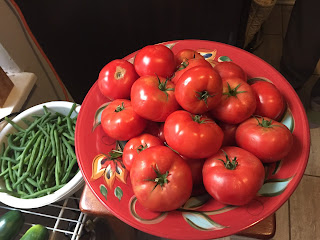Canning & Pickling
An impromptu workshop in an ongoing effort to teach food preservation through
For several years students have been interested in learning ways of preserving garden harvests, particularly canning. It's a difficult activity on campus because we need a stovetop. In the meantime, it worked to have a few UFO'ers for a little workshop.
- hot packing tomatoes for pressure canning
- spiced peaches recipe for the boiling canning
- pickling green beans
HOT PACKING TOMATOES FOR PRESSURE CANNING
Blanching Tomatoes to remove the skin:
1 boiling pot of water, to boil tomatoes in for 30-60 seconds or until the sin cracks
1 bowl of ice water, tomatoes are placed in the ice water after skin cracks in the boiling water. This helps remove the skin and cool the tomatoes for handling, but the tomatoes are still plenty hot! We could have removed the stems before boiling, but they popped off regardless.
Add 2 tablespoons and 1 tsp of salt of lemon juice to each jar. And the lemon juice is the bottled store bought stuff because we add this to lower the pH enough to reduce risk of pathogens, particularly botulism (< 4.6). The temptation is there to use whole ingredients rather than processed one, but whole lemons are not tested for pH but bottles lemon juice is regulated to be under the required canning pH.
Cut each tomato in half and watch out! The tomatoes are still really hot, especially on the inside.
Pack in tight using spacer. Fill jars leaving 1/2 inch headspace
Once jars were packed, we put on new lids sterilized and warmed along with bands and jars in the dishwasher. We used a Presto Pressure Canner and Cooker and followed the directions for pressure canning raw tomatoes (25 minutes at 11pound pressure. Each canner should come with its own processing manual and recipes from the manufacturer. Be careful to ensure you have your model's specific processing instructions before purchasing, particularly when tempted to purchase canners at resale stores.
The art of this pressure canner is to keep an eye on the gauge and continue to adjust your burner accordingly. Remember: processing time begins once the gauge reaches the pounds of pressure indicated by the instructions. We did not begin our timer for 25 minutes until the gauge read 11 pound pressure. We began the peaches as these tomato jars processed and found our pressure to build past 11. A couple of times we had to turn the heat very low to keep the gauge needle from climbing.
 |
| Presto Pressure Canner and Cooker pictured without the regulator on vent and with safety lock down (unengaged). |
BOIL CANNING HONEY SPICED PEACHES
Removing skins of peaches (much more difficult than tomatoes). Before placing peaches in boiling water we cut an "x" into the skin. Boiling still seemed to take much longer than the 30-60 seconds suggested in the recipe, and even placing peaches in ice water, the skin was very stubborn. At one point we resorted to a hand peeler and it was still not an easy removal.

We followed this Ball recipe to create packing syrup, pack, and process: http://www.freshpreserving.com/recipes/honey-spiced-peaches

Both the tomato and peach jars were left to sit undisturbed for 24 hours to seal.
PICKLING DILLY GREEN BEANS
How easy pickling is after canning! And less hot. I should mention all of this was done on a beautifully cool and breezy September day near the coast of Lake Michigan! Otherwise I would have run the air conditioning because canning is a hot endeavor!
Making the brine. Vinegar, water, dill and pickling spices to follow any recipe such as http://www.epicurious.com/recipes/food/views/dilly-beans-366717. Just boil ingredients, clean and prepare vegetables (we washed and snapped off ends of green beans). Then pack veggies in jars and once boiled, turn off heat and add the brine. Lid and band, let sit for 2 weeks then refrigerate and enjoy. They can keep without canning for 2 weeks or you can process according to a boiling or pressure canner instructions.


 |
| Sometimes hunting around for spices can lead to cheaper, local, or less processed choices. Here the more local company was also more cheaply priced. Be sure to check around the produce section for some alternative choices. You can always consider making your own pickling spice as well: homemade pickling recipes |












